A Novel Fault Classification Approach for Photovoltaic Systems
Abstract
1. Introduction
2. PV System Faults
3. Feature Extraction Methodology
Wavelet Transform
4. Pattern Classification Using RBFN
5. Methodology
5.1. System Layout and Data Collection
5.2. Classification Algorithm
5.3. Fault Detection Results
6. Conclusions
Author Contributions
Funding
Conflicts of Interest
References
- Parida, B.; Iniyan, S.; Goic, R. A review of solar photovoltaic technologies. Renew. Sustain. Energy Rev. 2011, 94, 779–791. [Google Scholar] [CrossRef]
- Shahsavari, A.; Akbari, M. Potential of solar energy in developing countries for reducing energy-related emissions. Renew. Sustain. Energy Rev. 2018, 90, 275–291. [Google Scholar] [CrossRef]
- Dumnic, B.; Liivik, E.; Milicevic, D.; Popadic, B.; Katic, V.; Blaabjerg, F. Fault Analysis and Field Experiences of Central Inverter Based 2 MW PV Plant. In Proceedings of the 2018 20th European Conference on Power Electronics and Applications (EPE’18 ECCE Europe), Riga, Latvia, 17 September 2018; pp. 1–10. [Google Scholar]
- Kurukuru, V.S.B.; Haque, A.; Khan, M.A. Fault Detection in Single-Phase Inverters Using Wavelet Transform-Based Feature Extraction and Classification Techniques. In Applications of Computing, Automation and Wireless Systems in Electrical Engineering; Springer: Singapore, 2019; pp. 649–661. [Google Scholar]
- Haque, A.; Bharath, K.V.S.; Khan, M.A.; Khan, I.; Jaffery, Z.A. Fault diagnosis of Photovoltaic Modules. Energy Sci. Eng. 2019. [Google Scholar] [CrossRef]
- Kurukuru, V.S.B.; Haque, A.; Khan, M.A.; Tripathy, A.K. Fault classification for Photovoltaic Modules Using Thermography and Machine Learning Techniques. In Proceedings of the 2019 International Conference on Computer and Information Sciences (ICCIS), Aljouf, Saudi Arabia, 3 April 2019; pp. 1–6. [Google Scholar]
- Ahmad, S.; Hasan, N.; Kurukuru, V.S.B.; Khan, M.A.; Haque, A. Fault Classification for Single Phase Photovoltaic Systems using Machine Learning Techniques. In Proceedings of the 2018 8th IEEE India International Conference on Power Electronics (IICPE), Jaipur, India, 13–15 December 2018; pp. 1–6. [Google Scholar]
- Zhao, Y.; De Palma, J.F.; Mosesian, J.; Lyons, R.; Lehman, B.; Zhao, Y.; De Palma, J.F.; Mosesian, J.; Lyons, R.; Lehman, B. Line–line fault analysis and protection challenges in solar photovoltaic arrays. IEEE Trans. Ind. Electron. 2013, 60, 3784–3795. [Google Scholar] [CrossRef]
- Nasrin, R.; Hasanuzzaman, M.; Rahim, N.A. Effect of high irradiation on photovoltaic power and energy. Int. J. Energy Res. 2018, 42, 1115–1131. [Google Scholar] [CrossRef]
- Hu, Y.; Zhang, J.; Cao, W.; Wu, J.; Tian, G.Y.; Finney, S.J.; Kirtley, J.L. Online Two-Section PV Array Fault Diagnosis with Optimized Voltage Sensor Locations. IEEE Trans. Ind. Electron. 2015, 62, 7237–7246. [Google Scholar] [CrossRef]
- Fatama, A.Z.; Haque, A.; Khan, M.A. A Multi Feature Based Islanding Classification Technique for Distributed Generation Systems. In Proceedings of the 2019 International Conference on Machine Learning, Big Data, Cloud and Parallel Computing (COMITCon), Faridabad, India, 14 Feberary 2019; pp. 160–166. [Google Scholar]
- Chen, K.Y.; Chen, L.S.; Chen, M.C.; Lee, C.L. Using SVM based method for equipment fault detection in a thermal power plant. Comput. Ind. 2011, 62, 42–50. [Google Scholar] [CrossRef]
- Morente-Molinera, J.A.; Mezei, J.; Carlsson, C.; Herrera-Viedma, E. Improving Supervised Learning Classification Methods Using Multigranular Linguistic Modeling and Fuzzy Entropy. IEEE Trans. Fuzzy Syst. 2017, 25, 1078–1089. [Google Scholar] [CrossRef]
- Zhao, Y.; Ball, R.; Mosesian, J.; de Palma, J.F.; Lehman, B. Graph-Based Semi-supervised Learning for Fault Detection and Classification in Solar Photovoltaic Arrays. IEEE Trans. Power Electron. 2014, 30, 2848–2858. [Google Scholar] [CrossRef]
- Li, L.; Ding, S.X.; Yang, Y.; Peng, K.; Qiu, J. A fault detection approach for nonlinear systems based on data-driven realizations of fuzzy kernel representations. IEEE Trans. Fuzzy Syst. 2018, 26, 1800–1812. [Google Scholar] [CrossRef]
- Aftab, W.; Moinuddin, M.; Shaikh, M.S. A novel kernel for RBF based neural networks. Abstr. Appl. Anal. 2014, 2014, 176253. [Google Scholar] [CrossRef]
- Tchakoua, P.; Wamkeue, R.; Ouhrouche, M.; Slaoui-Hasnaoui, F.; Tameghe, T.; Ekemb, G. Wind turbine condition monitoring: State-of-the-art review, new trends, and future challenges. Energies 2014, 7, 2595–2630. [Google Scholar] [CrossRef]
- Jordan, D.C.; Silverman, T.J.; Sekulic, B.; Kurtz, S.R. PV degradation curves: Non-linearities and failure modes. Prog. Photovolt. Res. Appl. 2017, 25, 583–591. [Google Scholar] [CrossRef]
- King, D.L.; Boyson, W.E.; Kratochvil, J.A. Analysis of factors influencing the annual energy production of photovoltaic systems. In Proceedings of the Conference Record of the Twenty-Ninth IEEE Photovoltaic Specialists Conference, New Orleans, LA, USA, 19–24 May 2002; pp. 1356–1361. [Google Scholar]
- Petrone, G.; Spagnuolo, G.; Teodorescu, R.; Veerachary, M.; Vitelli, M. Reliability Issues in Photovoltaic Power Processing Systems. IEEE Trans. Ind. Electron. 2008, 55, 2569–2580. [Google Scholar] [CrossRef]
- Khan, M.A.; Haque, A.; Kurukuru, V.S.B. An Efficient Islanding Classification Technique for Single Phase Grid Connected Photovoltaic System. In Proceedings of the 2019 International Conference on Computer and Information Sciences (ICCIS), Aljouf, Saudi Arabia, 3–4 April 2019; pp. 1–6. [Google Scholar]
- He, J.; Yu, B. Continuous wavelet transforms on the space L2 (R, H; dx). Appl. Math. Lett. 2004, 17, 111–121. [Google Scholar] [CrossRef]
- Mallat, S. A Wavelet Tour of Signal Processing, 3rd ed.; The Sparse Way; Academic Press: Cambridge, MA, USA, 2008. [Google Scholar]
- Stéphane, M. Time Meets Frequency. In A Wavelet Tour of Signal Processing; Elsevier: Amsterdam, The Netherlands, 2009; pp. 89–153. [Google Scholar]
- Han, M.; Guo, W.; Mu, Y. A modified RBF neural network in pattern recognition. In Proceedings of the 2007 International Joint Conference on Neural Networks, Orlando, FL, USA, 12–17 August 2007; pp. 2527–2532. [Google Scholar]
- Wang, W.; Xu, Z.; Lu, W.; Zhang, X. Determination of the spread parameter in the Gaussian kernel for classification and regression. Neurocomputing 2003, 55, 643–663. [Google Scholar] [CrossRef]
- Mai-Duy, N.; Tran-Cong, T. Numerical solution of Navier-Stokes equations using multiquadric radial basis function networks. Int. J. Numer. Methods Fluids 2001, 37, 65–86. [Google Scholar] [CrossRef]
- Mongillo, M. Choosing Basis Functions and Shape Parameters for Radial Basis Function Methods. SIAM Undergrad. Res. Online 2011, 4, 190–209. [Google Scholar] [CrossRef]
- Danielsson, P.E. Euclidean distance mapping. Comput. Graph. Image Process. 1980, 14, 227–248. [Google Scholar] [CrossRef]
- Meza, J.C. Steepest descent. Wiley Interdiscip. Rev. Comput. Stat. 2010, 2, 719–722. [Google Scholar] [CrossRef]
- Khan, M.A.; Haque, A.; Kurukuru, V.S.B. Performance Assessment of Stand-Alone Transformerless Inverters. 2020. Available online: https://onlinelibrary.wiley.com/doi/abs/10.1002/2050-7038.12156 (accessed on 7 January 2020).
- Khan, M.A.; Haque, A.; Kurukuru, V.S.B. Control and Stability Analysis of H5 Transformerless Inverter Topology. In Proceedings of the 2018 International Conference on Computing, Power and Communication Technologies (GUCON), Greater Noida, India, 28–29 September 2018; pp. 310–315. [Google Scholar]
- Khan, M.A.; Haque, A.; Kurukuru, V.S.B. Hybrid Voltage Control for Stand Alone Transformerless Inverter. In Proceedings of the IEEE International Conference on Power Electronics, Intelligent Control and Energy 2018 (ICPEICES), New Delhi, India, 22–24 October 2018. [Google Scholar]
- Daubechies, I. Ten Lectures of Wavelets; Springer: Berlin/Heidelberg, Germany, 1992; p. 357. [Google Scholar]
- Kim, D.W.; Lee, K.; Lee, D.; Lee, K.H. A kernel-based subtractive clustering method. Pattern Recognit. Lett. 2005, 26, 879–891. [Google Scholar] [CrossRef]
- Sarimveis, H.; Alexandridis, A.; Bafas, G. A fast training algorithm for RBF networks based on subtractive clustering. Neurocomputing 2003, 51, 501–505. [Google Scholar] [CrossRef]
- Yang, P.; Zhu, Q.; Zhong, X. Subtractive clustering based RBF neural network model for outlier detection. J. Comput. 2009, 4, 755–762. [Google Scholar] [CrossRef]
- Uyar, M.; Yildirim, S.; Gencoglu, M.T. An effective wavelet-based feature extraction method for classification of power quality disturbance signals. Electr. Power Syst. Res. 2008, 78, 1747–1755. [Google Scholar] [CrossRef]
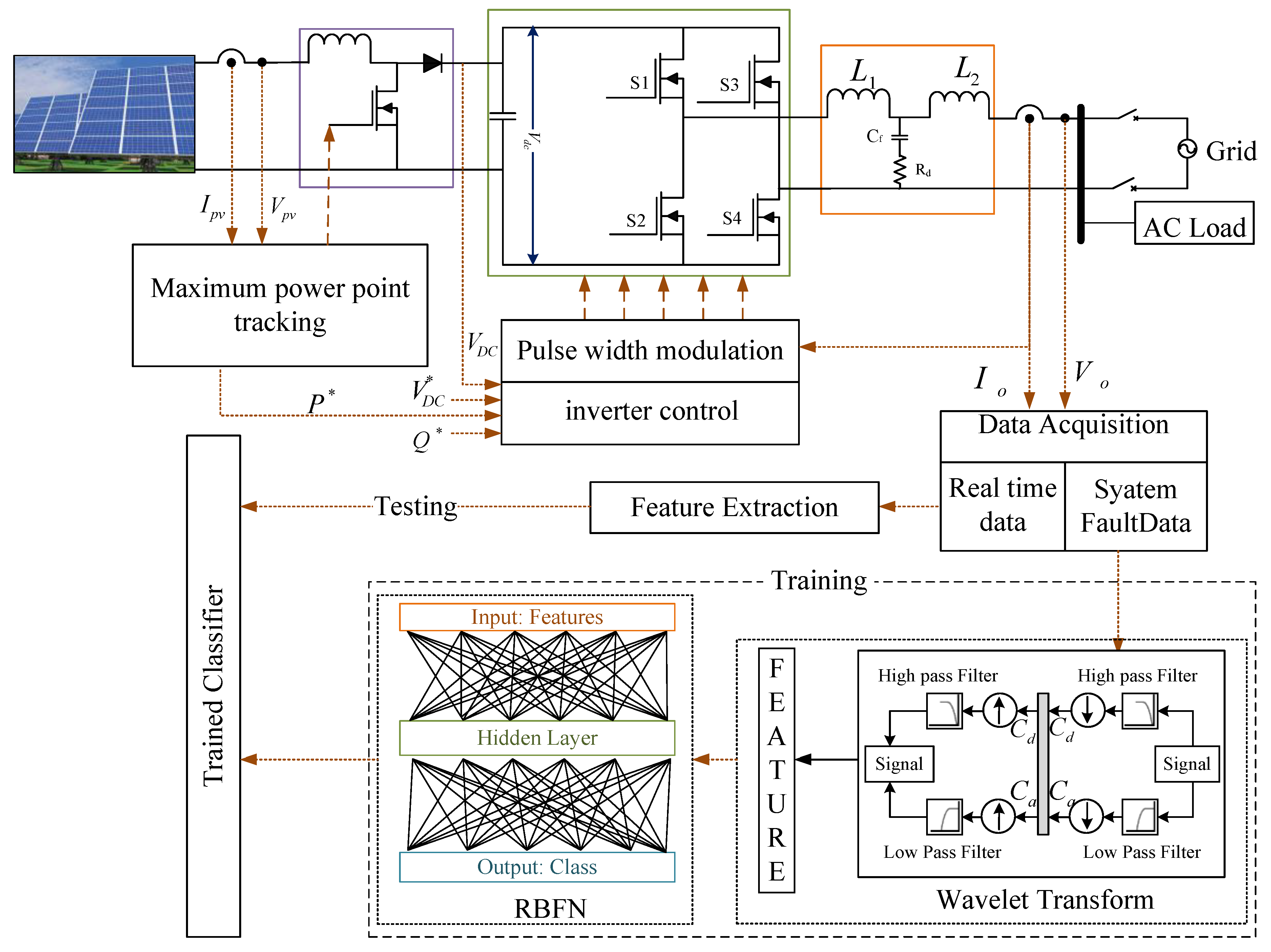
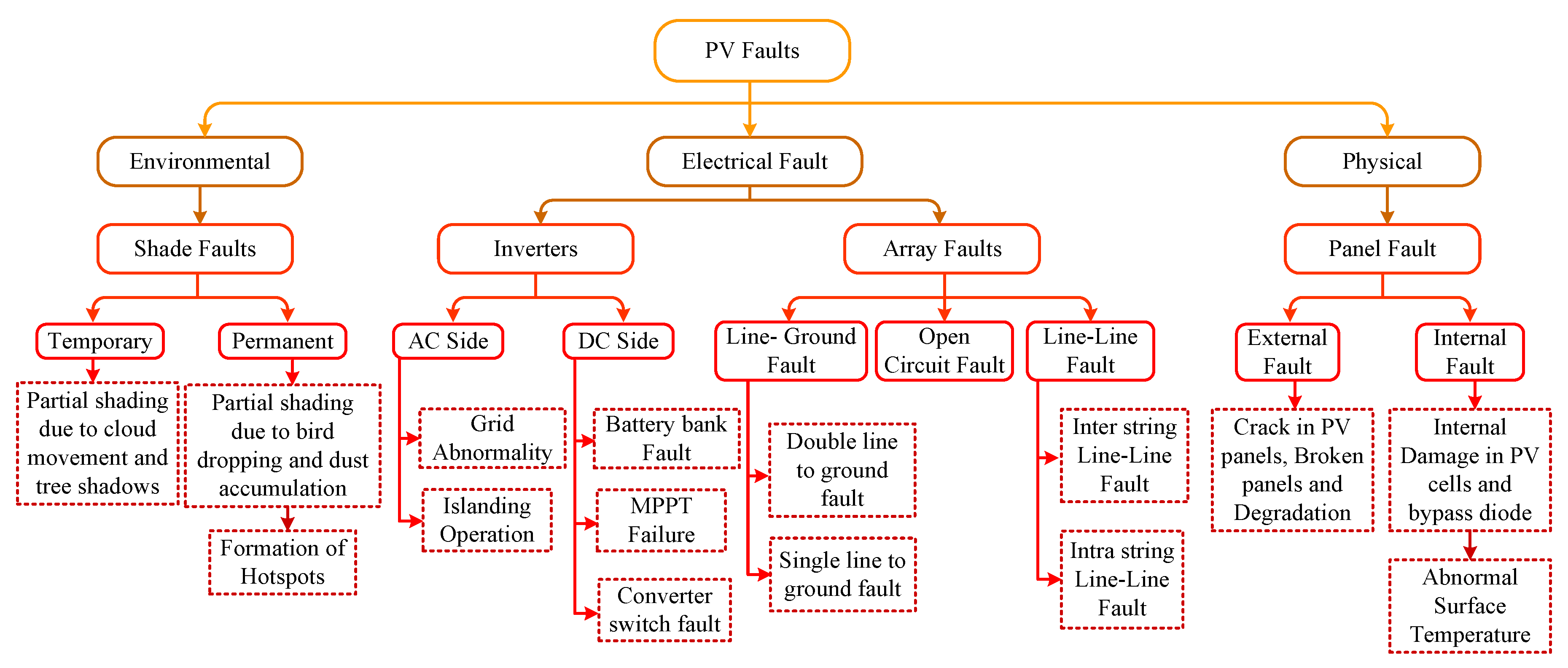
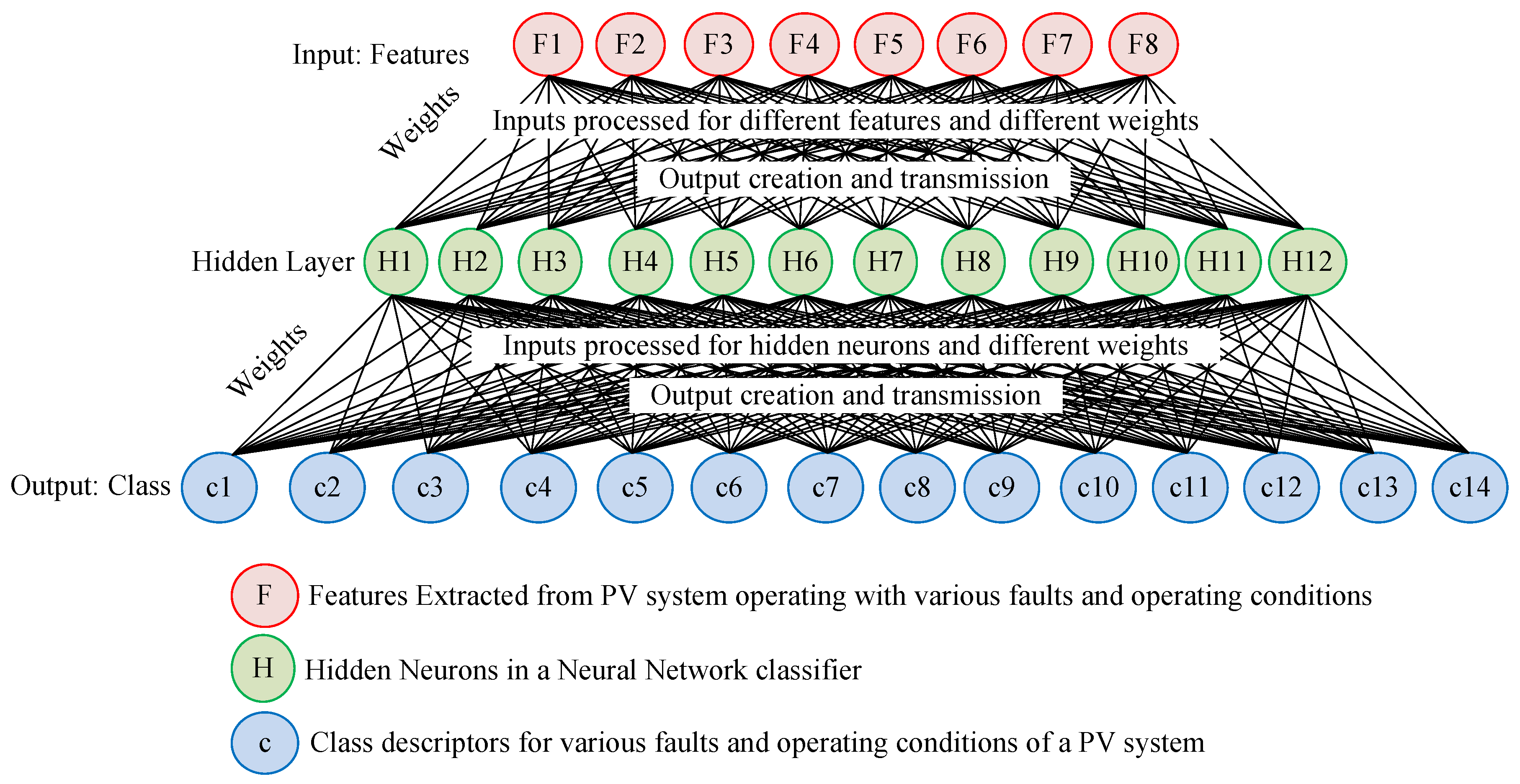
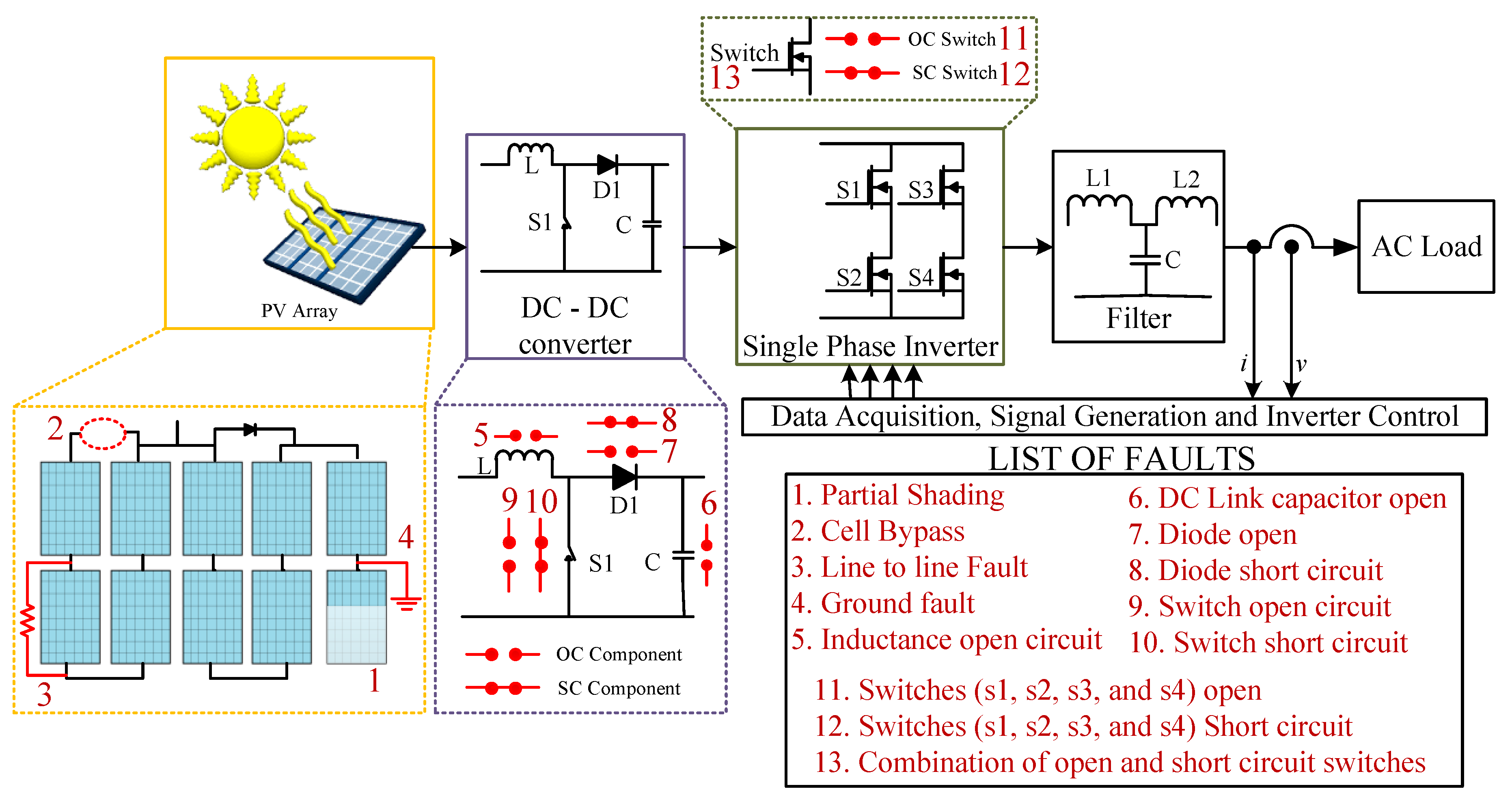
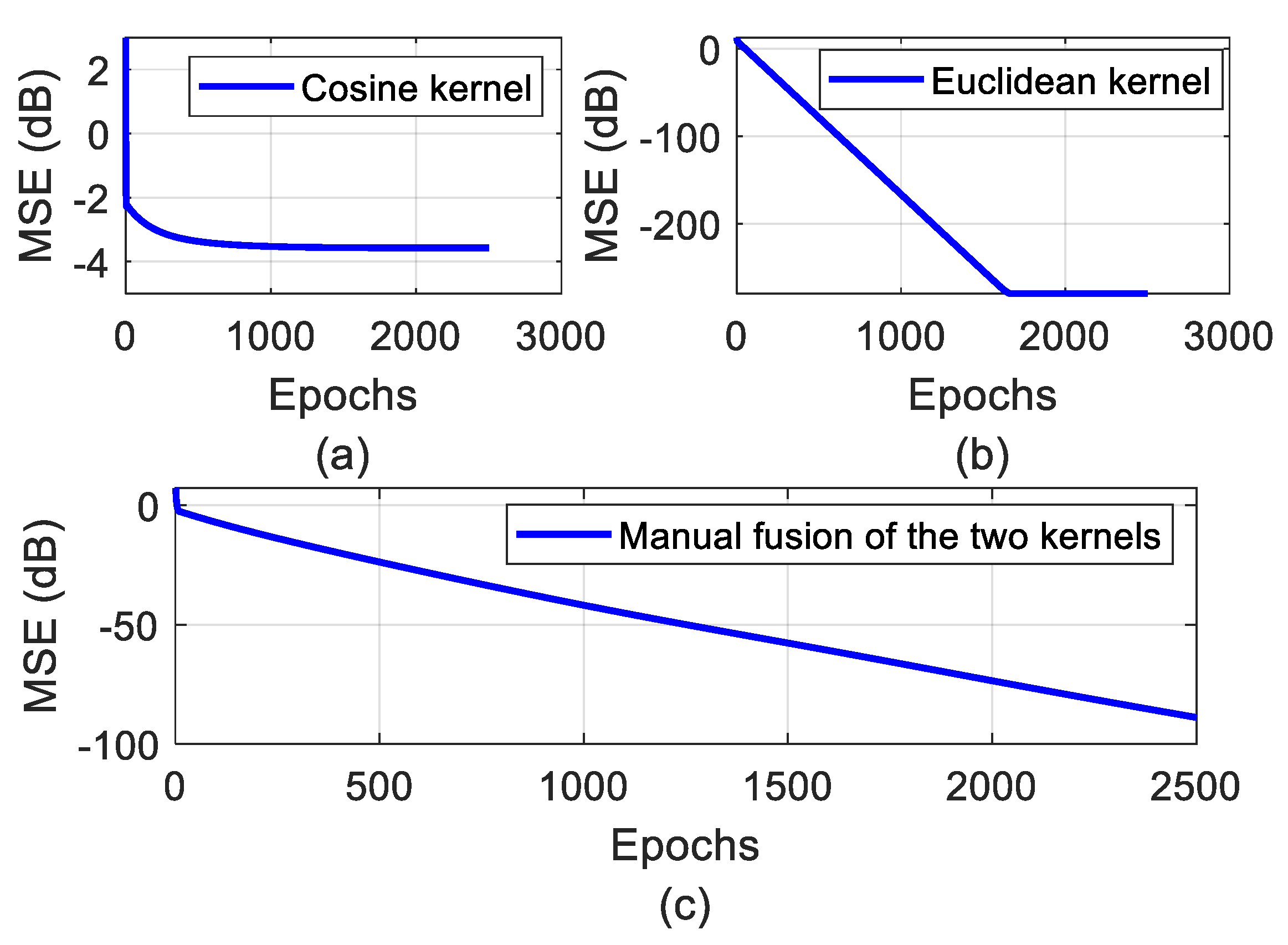
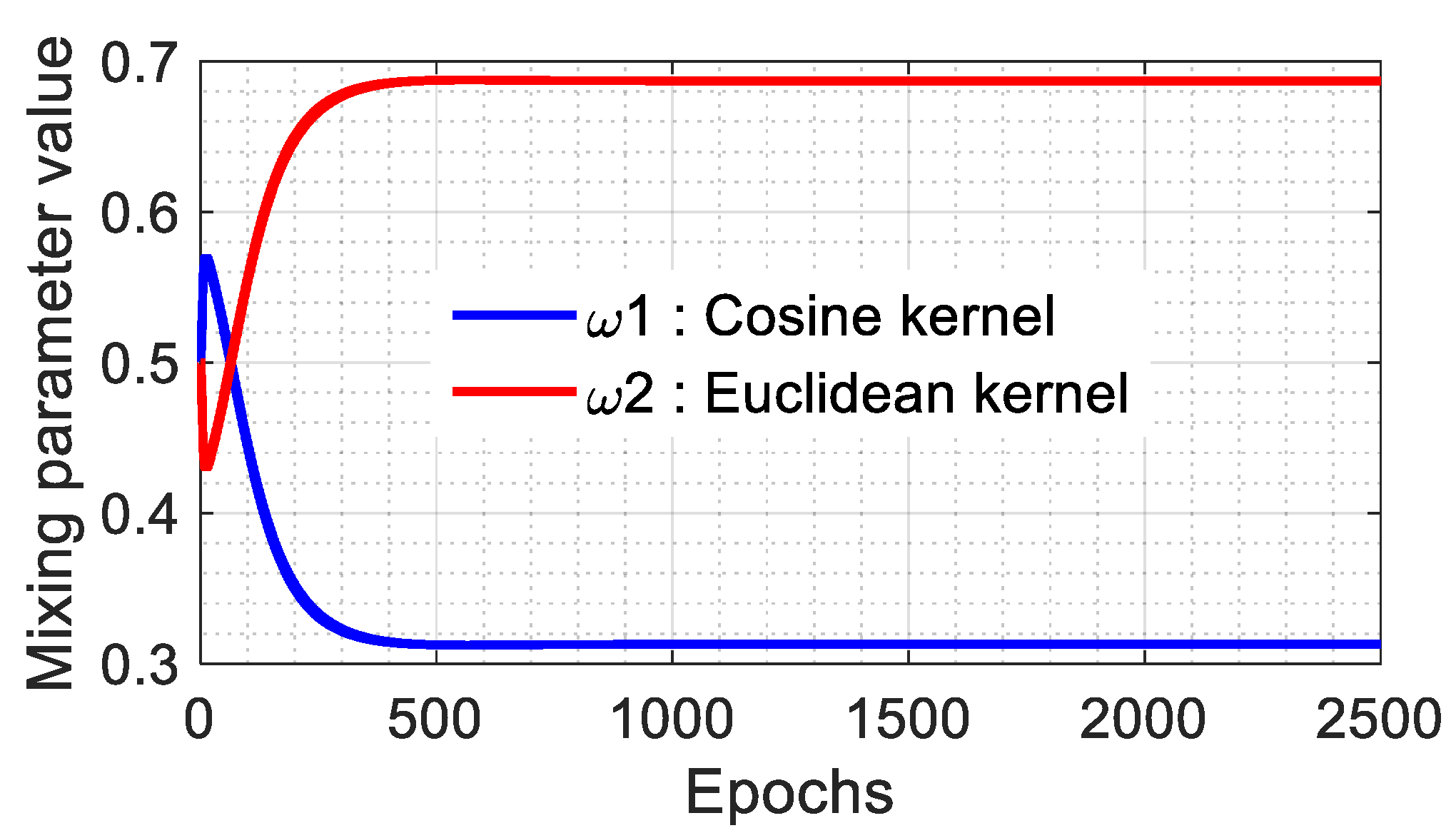
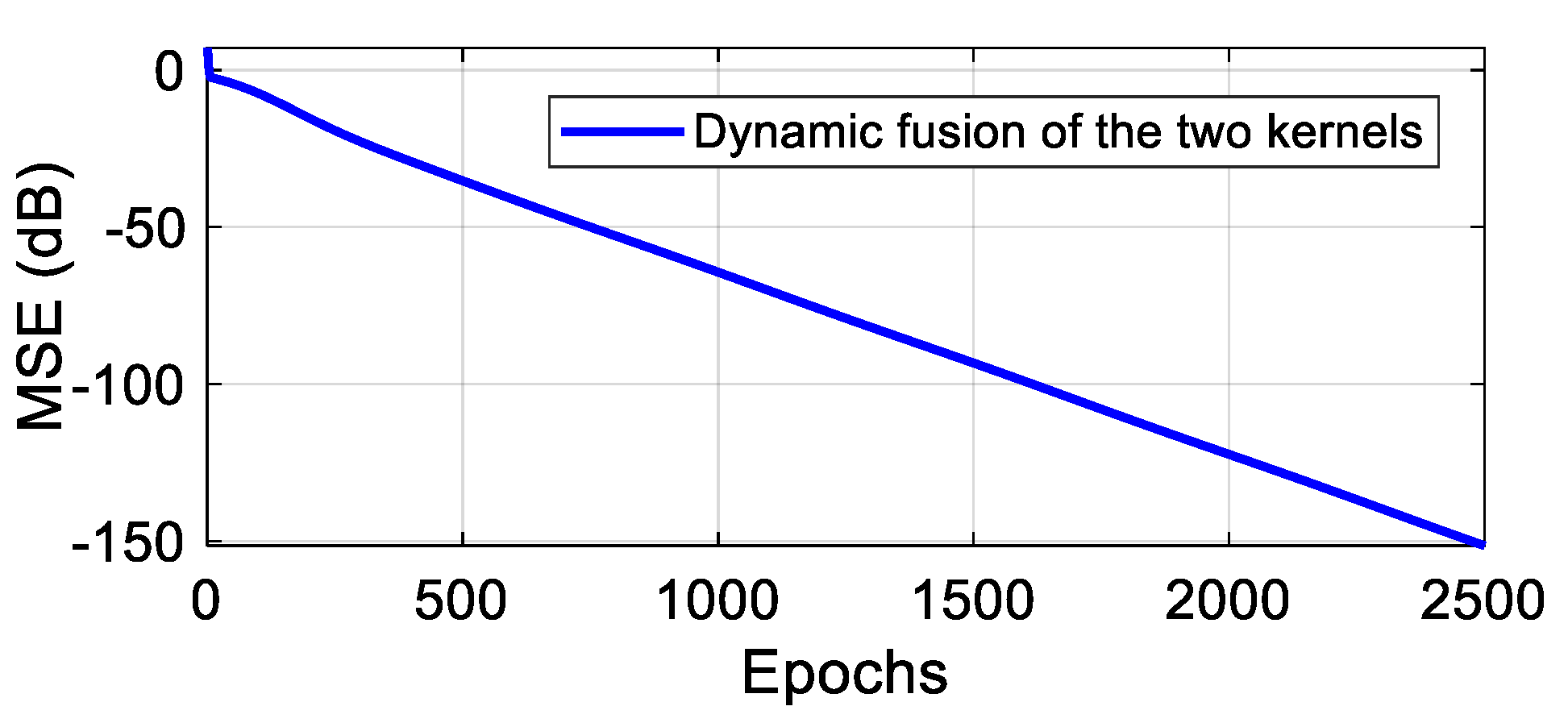
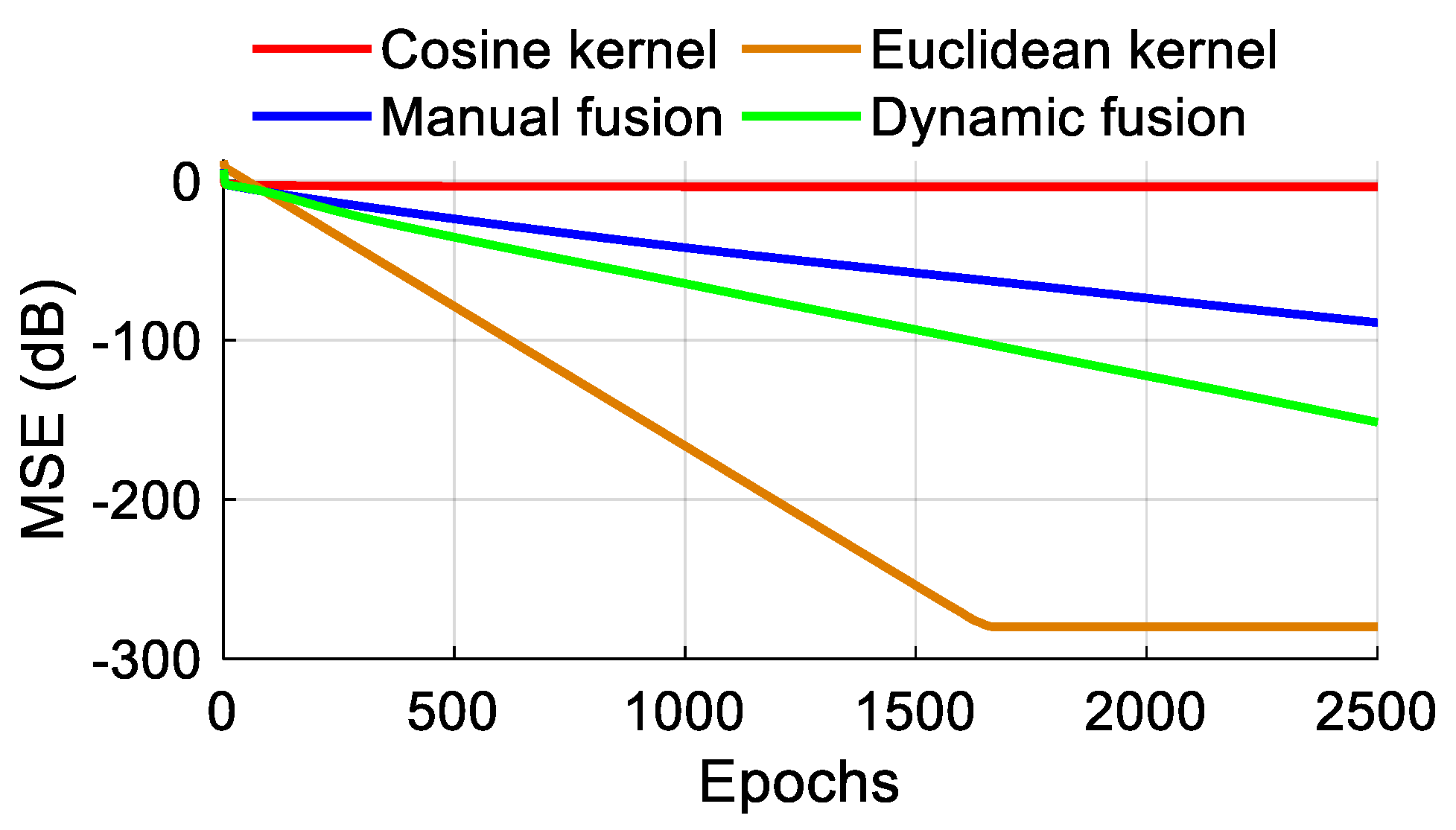
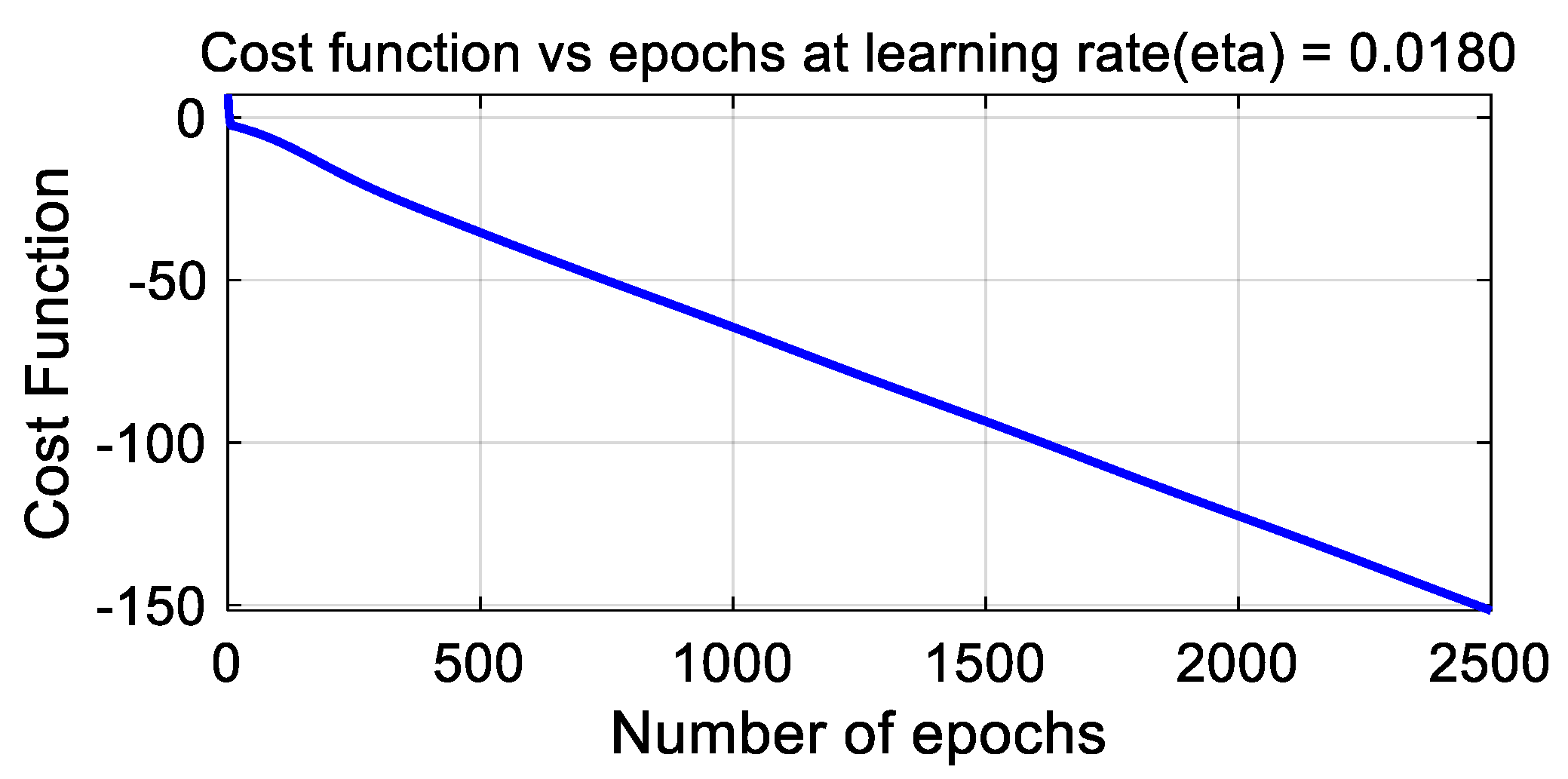
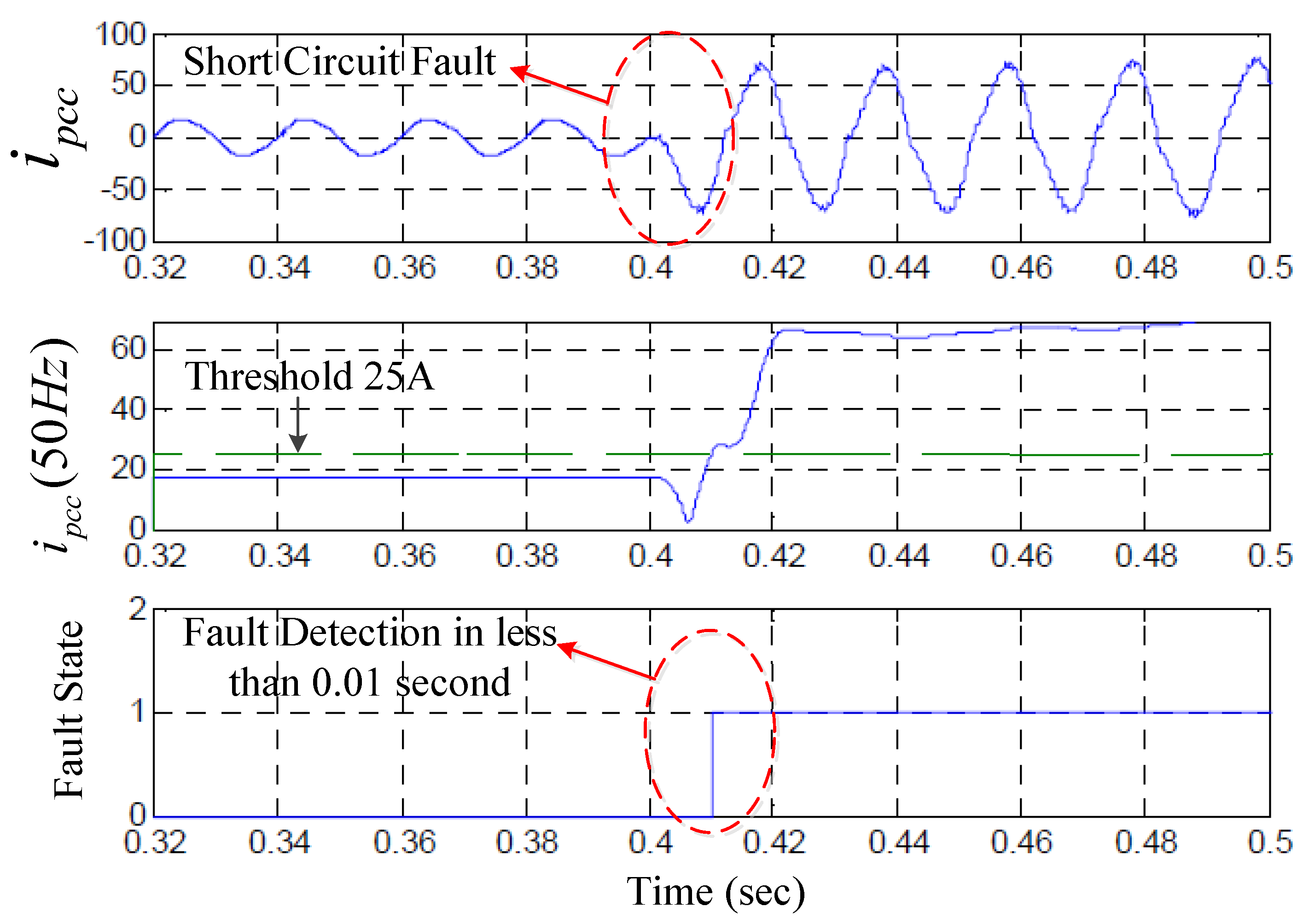
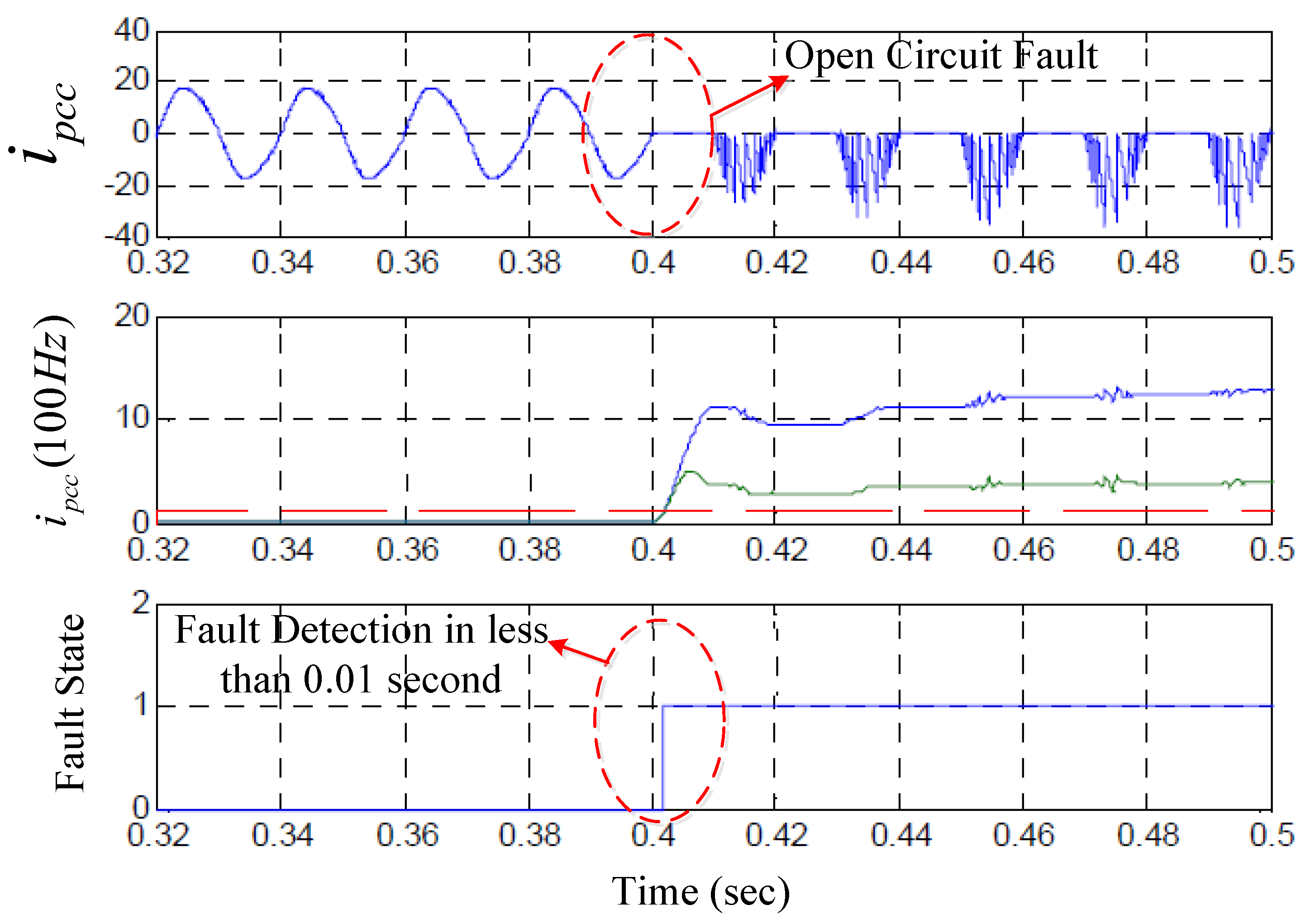
| Fault Type | Potential Cause | Potential Effect |
|---|---|---|
| Module Failure (loss of electrical function) | Open contacts, Short circuit and arcing | No energy output |
| Impairment of electric function | High series resistance, low shunt resistance, aging, shading, soiling | Reduced energy output, hot spot damage |
| Junction box/bypass diode open contacts | Disconnections, improper installation, corrosion, | No energy output |
| Short, arc in contacts | Damaged insulation, aging, and lightning. | No energy output, thermal damages, fire |
| Inverter fails to transfer | Contact damage, excessive heating of switches, software failure with gating pulses | Distorted or No energy output |
| Degraded output | MPPT unbalance, Extreme weather conditions | Reduced energy output |
| Spurious trip | Bad system configuration, corrosion, aging, lack of maintenance | No energy output |
| Component | Operating Condition | Description |
|---|---|---|
| PV System (1 kW) | Normal Operation (N. O) | Operated under standard test conditions. |
| PV Module | Partial Shading (Fault 1) | Low power output from the modules |
| cell bypass (Fault 2) | Low power output from the modules | |
| PV Array | Line to Line Fault (Fault 3) | Negative current from the faulted string (back-fed current) |
| Ground Faults (Fault 4) | Undesirable condition of current flowing through the equipment grounding conductor in the circuits carrying DC power | |
| Boost converter | Inductance open circuit (Fault 5) | Inductor is disconnected from the boost converter circuit resulting in a maximum DC component of the VI (voltage current characteristic) curve. |
| DC link capacitance open (Fault 6) | The positive point of the DC link capacitor is disconnected, which results in a highly abnormal DC component. | |
| Diode open (Fault 7) | One terminal of boost converter diode is disconnected, which results in a nullified frequency of the component. | |
| Diode short circuit (Fault 8) | Boost converter diode is short-circuited by using a cable, which results in a change of voltage magnitude. | |
| Switch open (Fault 9) | The MOSFET is disconnected or open-circuited due to bond wire lift off, resulting in a nullified frequency of the component. | |
| Switch short circuit (Fault 10) | The MOSFET is shorted, which results in the minimum DC component of the IV curve. | |
| Switches (s1, s2, s3, and s4) open (Fault 11) | The switches of inverter were disconnected one at a time along with the diode, and the corresponding effects were observed. | |
| Inverter | Switches (s1, s2, s3, and s4) short circuit (Fault 12) | The power switches and diode of inverter were short-circuited one at a time, and the corresponding effects were observed. |
| Combination of open and short-circuit switches (Fault 13) | Open and short circuit combinations of switches in both the converter circuits were tested, and the corresponding system operation is observed. |
| Kernel Type | Training Process | Testing Process | ||
|---|---|---|---|---|
| Cosine | 100% | 94.11% | 0.57 | 0.429 |
| Gaussian Euclidian | 100% | 58.82% | 0.573 | 0.426 |
| Manual Fusion | 100% | 94.16% | 0.5 | 0.5 |
| Dynamic Fusion | 100% | 97.05% | 0.576 | 0.426 |
| Fault Location | Testing Efficiency | ||||
|---|---|---|---|---|---|
| 20 dB | 30 dB | 40 dB | 50 dB | ||
| No Fault | 100% | 98.84% | 97.61% | 97.59% | |
| Boost Converter | Fault 1 | 98.72% | 98.68% | 97.28% | 97.52% |
| Fault 2 | 98.63% | 96.23% | 98.39% | 98.25% | |
| Inverter | Fault 1 | 99.16% | 96.35% | 97.28% | 96.94% |
| Fault 2 | 96.44% | 97.22% | 96.47% | 97.34% | |
© 2020 by the authors. Licensee MDPI, Basel, Switzerland. This article is an open access article distributed under the terms and conditions of the Creative Commons Attribution (CC BY) license (http://creativecommons.org/licenses/by/4.0/).
Share and Cite
Kurukuru, V.S.B.; Blaabjerg, F.; Khan, M.A.; Haque, A. A Novel Fault Classification Approach for Photovoltaic Systems. Energies 2020, 13, 308. https://doi.org/10.3390/en13020308
Kurukuru VSB, Blaabjerg F, Khan MA, Haque A. A Novel Fault Classification Approach for Photovoltaic Systems. Energies. 2020; 13(2):308. https://doi.org/10.3390/en13020308
Chicago/Turabian StyleKurukuru, Varaha Satya Bharath, Frede Blaabjerg, Mohammed Ali Khan, and Ahteshamul Haque. 2020. "A Novel Fault Classification Approach for Photovoltaic Systems" Energies 13, no. 2: 308. https://doi.org/10.3390/en13020308
APA StyleKurukuru, V. S. B., Blaabjerg, F., Khan, M. A., & Haque, A. (2020). A Novel Fault Classification Approach for Photovoltaic Systems. Energies, 13(2), 308. https://doi.org/10.3390/en13020308






